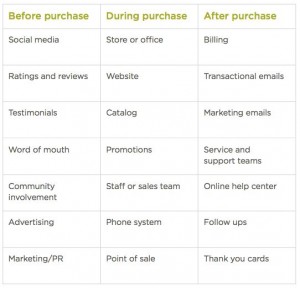As May flowers began to bloom in the Northern Hemisphere, our content dwelled upon expanding into the Brazilian ecommerce marketplace, growing the value of your ecommerce venture, and improving the Quality Score of your paid search efforts.
For our Ecommerce Digest this month, we’re discussing the amount and variety of customer touchpoints, the implication of a Google buy button, how to optimize subject lines in email marketing, how to present choices to your customers, and the difficulty of expanding into the Chinese ecommerce market.
Customer Touchpoints

Source: SurveyMonkey
How to Identify Your Customer Touchpoints | SurveyMonkey
Do you ever think about just how many places your customers are encountering your brand? Does it keep you up at night? This piece of thought leadership from SurveyMonkey asks the simple but powerful question, “What are customer touchpoints?” It answers, “Customer touchpoints are your brand’s points of customer contact, from start to finish. For example, customers may find your business online or in an ad, see ratings and reviews, visit your website, shop at your retail store, or contact your customer service. Seems like a long list, but these are just a few of your touchpoints!”
This page also includes a chart that would be good for you to review against your current efforts to attract visitors to your online store. In the end, the customer experience at these touchpoints is going to be the ‘make or break’ factor in your ability to drive revenue and retain customers.
Google Buy Button
According to a recent report from the Wall Street Journal, Google will soon begin featuring buy buttons for paid search results on mobile devices, but not for desktop searches. Since mobile searches now outnumber those on PCs in countries like the U.S. and Japan, and since mobile shoppers are likely to shop on native apps from eBay and Amazon, Google is trying to work with retailers to keep generating revenue from PPC ads.
Ostensibly, the payment information that flows through the Google buy button will be stored on users’ mobile browsers, though this may provoke consternation with retailers who wish to own their customers’ payment information. Both the Motley Fool and Business 2 Community blogs point out that Google also needs to work with retailers so that they do not lose out on brand equity. Yet another challenge to this latest attempt by Google to penetrate the retail market will be how it handles customer service.
Email Marketing – Subject Line Length

Source: ClickZ ( Image based on Alchemy Worx data)
Are Your Subject Lines Strong Enough? | ClickZ
Email marketing can provide a much needed boost to your bottom line—provided you do it in the right way. Important KPIs for email marketing include open and click rates, and one way to move the needle on these metrics is to test subject lines.
This post from ClickZ teaches that it’s valuable to consider shorter subject lines (for a more nuanced understanding about subject line length, I recommend reading this resource from Phrasee), especially in view of a growing mobile audience. It also provides some tried and true data from expert email marketers on the best and worst performing words in subject lines.
Web Design and User Experience
Designing for Explicit Choice | Smashing Magazine
Should you lead customers by the hand with a default option, or give them enough information to allow them to proactively choose what they want? As ecommerce professionals, your main task is to influence choice. It’s not just about persuading visitors to choose your company over your competitors. It’s also about getting them to choose an upsell or renew a subscription product. This blog post does an in-depth exploration of your different options for presenting … well, options for visitors to your site.
International Expansion
Netflix Said in Talk to Enter China | Bloomberg
We’ve previously mentioned that according to Forrester Research, “International expansion is top of mind for many eBusiness executives.” Companies who provide access to media like films and television, like Netflix, certainly have their own unique obstacles to overcome as they try to expand into growth markets like China. Still, any type of global expansion into the ecommerce behemoth that is China will engender tough challenges. Even getting Chinese consumers to access your site might be a struggle (Google, Facebook and YouTube are all blocked on the mainland). Other issues to overcome will be the need to find local business partners in order to even get one’s foot in the door. Aside from that, competition in China is fierce, as local players dominate.